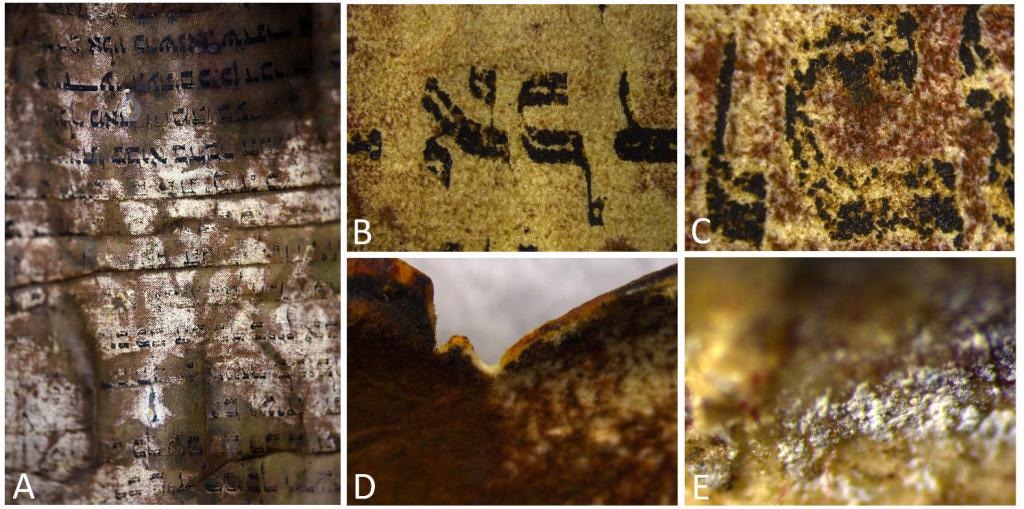Dec 21 2020
A famous adage says 'a picture is worth a thousand words.' However, multiple images of an artifact captured over the electromagnetic spectrum can reveal a rich story related to the original creation and degradation of historical objects as time passes.
 Details of the scroll, showing various types of degradation. Image Credit: The authors.
Details of the scroll, showing various types of degradation. Image Credit: The authors.
Recently, a team of scientists showed how this was viable with the help of multiple complementary imaging methods for non-invasively probing a Jewish parchment scroll. The findings of the study were published in the Frontiers in Materials journal.
Researchers at Romania’s National Institute for Research and Development in Optoelectronics derived details related to the original materials and manufacturing methods of the manuscript by using different spectroscopic instruments. These exclusive cameras and devices capture images that cannot be viewed by the human eye normally.
The goal of the study was ... to understand what the passing of time has brought upon the object, how it was degraded, and what would be the best approach for its future conservation process.
Dr Luminita Ghervase, Study Co-Author and Research Scientist, National Institute for Research and Development in Optoelectronics
The manuscript investigated by the researchers was a poorly preserved yet sacred scroll that includes many chapters of the Book of Esther from the Hebrew Bible. The object was an artifact from a private collection and little was known about its history or provenance.
The use of complementary investigation techniques can shed light on the unknown history of such an object. For some years now, non-invasive, non-destructive investigation techniques are the first choice in investigating cultural heritage objects, to comply with one of the main rules of the conservation practice, which is to not harm the object.
Dr Luminita Ghervase, Study Co-Author and Research Scientist, National Institute for Research and Development in Optoelectronics
Multispectral imaging is one of the more common imaging methods where an object is scanned within particular parts of the electromagnetic spectrum. Such images can reveal details related to the wear and tear of the manuscript that are otherwise invisible.
Multiple ultraviolet modes, for instance, unraveled a dark stain on the scroll that could suggest a repair with an organic material like a resin, since the spot tends to absorb UV light strongly.
Hyperspectral imaging is an associated technique and was used to identify the material basis of the ink found on the aged parchment. The team detected two different types of ink, another sign that attempts might have been made to repair the item in the past.
Moreover, they used a computer algorithm to characterize the spectral signals of individual pixels to further differentiate the materials—a technique with the potential for reconstructing the text itself.
“The algorithm used for materials classification has the potential of being used for identifying traces of the ink to infer the possible original shape of the letters,” added Ghervase.
The researchers also used an imaging method called x-ray fluorescence (XRF) that can help determine the types of chemicals used both in the ink and to produce the parchment. For example, the XRF revealed higher concentrations of zinc, a chemical usually associated with the bleaching process, but probably another sign of past restoration efforts.
Lastly, the team used a Fourier-transform infrared (FTIR) spectrometer to determine other chemicals present in the parchment, with the help of an infrared light source to quantify absorption. Most importantly, the FTIR analysis offered an in-depth insight with respect to the deterioration rate of the collagen present in the scroll, which is manufactured using animal skin, apart from other views.
The use of such different imaging methods to examine the parchment could enable conservators to restore the object closer to its original condition by determining the materials used to manufacture it.
They can wisely decide if any improper materials had been used, and if such materials should be removed. Moreover, restorers can choose the most appropriate materials to restore and preserve the object, ruling out any possible incompatible materials.
Dr Luminita Ghervase, Study Co-Author and Research Scientist, National Institute for Research and Development in Optoelectronics
Journal Reference:
Cortea, I. M., et al. (2020) Application of Spectroscopic and Hyperspectral Imaging Techniques for Rapid and Nondestructive Investigation of Jewish Ritual Parchment. Frontiers in Materials. doi.org/10.3389/fmats.2020.601339.